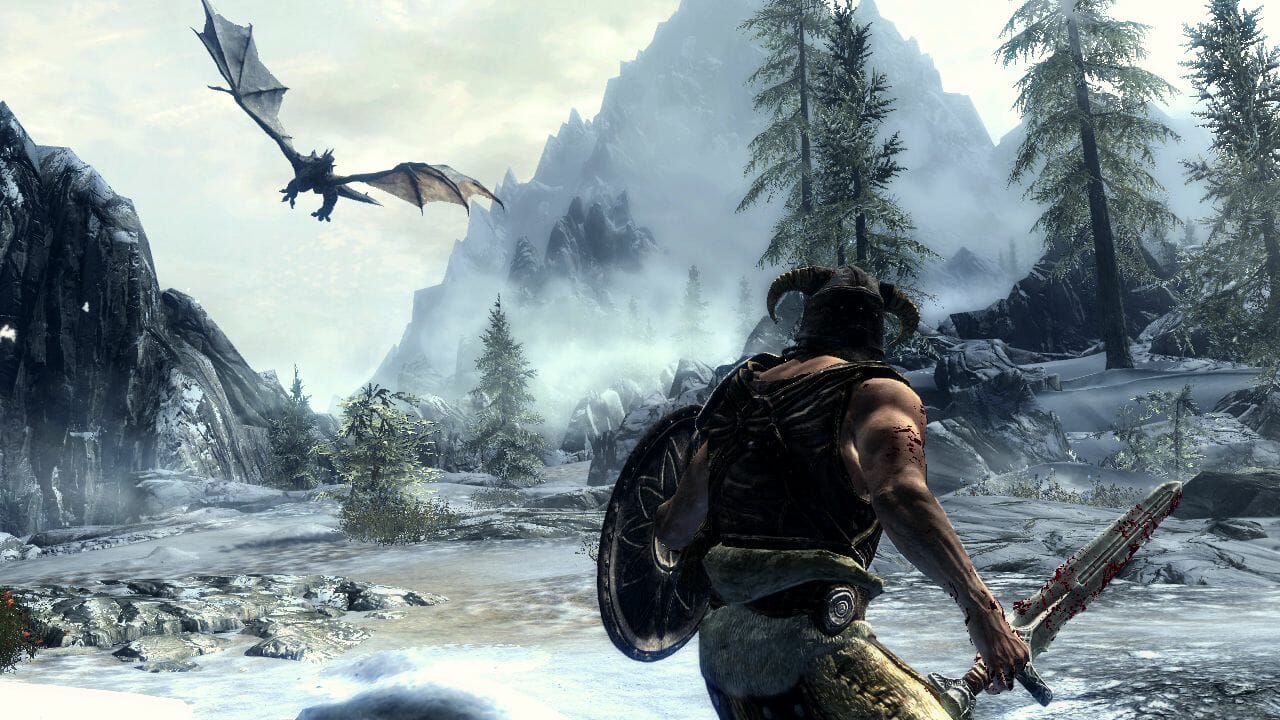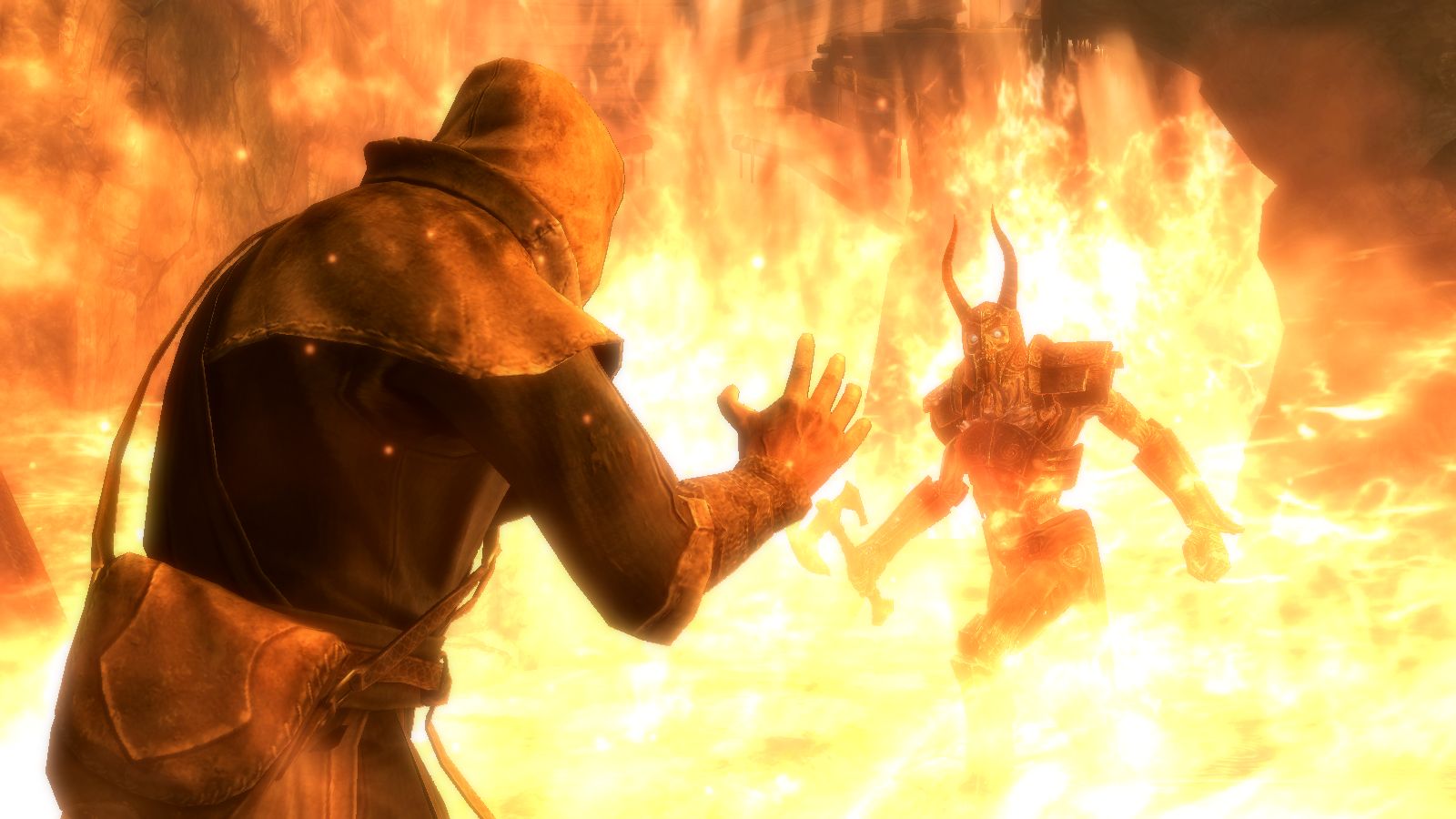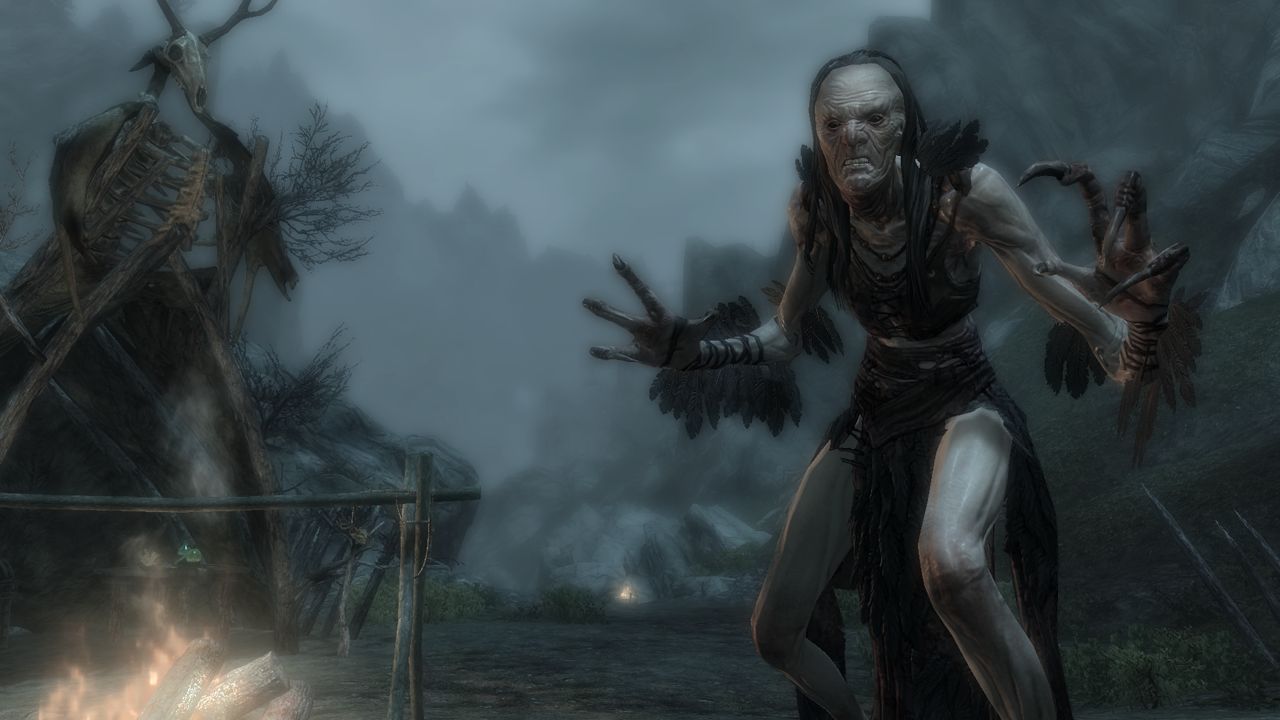
Ah, we come from the land of the ice and snow, from the midnight sun where the hot springs blow.
The word “epic” gets thrown around a lot these days. Screw up badly enough and it’s an epic fail. Scarf down a couple of cheeseburgers and it’s suddenly an epic feast. The word no longer has the punch it once had. Yet, there’s really no other adjective that so aptly describes The Elder Scrolls V: Skyrim, a game that’s epic in every sense of the word, from its immersive gameplay and jaw dropping visuals, to its sprawling storyline rooted in the real-world epics of Norse mythology. At the risk of fanboy-induced hyperbole, there really is nothing that comes close to approaching Skyrim as a game whose scope, design and presentation sets a new bar for the action-RPG genre.
As the fifth entry in Bethesda’s Elder Scrolls series, the game is once again set in the world of Tamriel, with the story picking up almost 200 years after the events of Oblivion. This time out, players find themselves in the sprawling kingdom of Skyrim, an ice-swept land of rugged mountains and untamed wilderness inhabited by the Viking-like Nords. Something is rotten in the state of Skyrim, however, with the country wracked by a civil war between the rebel Stormcloaks and the Imperial Army which has long occupied the disputed territory. To make matters worse, after centuries of inactivity, dragons have begun to return to the land, wreaking havoc and adding to the growing panic among the kingdom’s war-weary population. It’s a complex and intricately crafted world filled with political machinations, strange creatures, eldritch powers and shifting allegiances. As the game begins, you quickly discover that your character is one of the Dragonborn, a race of long forgotten and long prophesized heroes who possess the soul of dragons and are capable of mastering “The Voice”, or Thu’um, which are spoken words of rare magical power.
The game’s storyline then unfolds as you alternate quests between the bloody realities of Skyrim’s civil war and fulfilling the ancient prophecy of the Dragonborn. Along the way you’ll explore the vast expanses of Skyrim, engage in various side quests, and encounter countless unique characters. Your silent-but-deadly protagonist might lack the dramatic gravitas of Mass Effect’s Commander Shepard, and conversations with the game’s NPCs tend to be fairly one-sided affairs that lack the immersive dialogue trees and complex ethical dilemmas of BioWare-style RPGs, but there’s still an impressive amount of choice in terms of which side you’ll choose and how you’ll approach the story. It’s a well-crafted and well-told narrative rooted in Norse mythology and borrowing liberally from the best elements of fantasy auteurs like Tolkien and George R. R. Martin.

In terms of gameplay, Skyrim foregoes the traditional elements of most western RPGs, sidestepping character classes and even traditional point-based attributes. Instead, the game is really about customizing your character based on your style of play. Players begin by choosing a base sex and race (which also includes some of Tamriel’s more exotic non-humans), each of which has its own specific special abilities. Instead of choosing a class and slotting points into your initial attributes, however, you’re presented with three base power meters which govern how much health, stamina and magic you have at any given time. Your character is then further augmented by a series of abilities in magic and combat as well as skills such as speech, smithing and pickpocketing. Advancing a specific skill, however, is simply a matter of repetition, rather than point allocation. Wield a sword in combat enough times and your one-handed combat skill will gradually improve. Blast enough streams of magical fire into your enemies and your Destruction magic skill will increase. The result is a flexible system that allows players to customize their character based not only on what they’re doing but on how they want to play the game. As you progress, levelling up earns you the option to increase the size of your three power bars in addition to rewarding you with specific “Perks” which you can spend to gain specific sub-abilities (for example, increased damage or improving the chance of a critical hit). It’s a simple yet incredibly effective system that works more towards adapting itself to a specific style of play rather than forcing players to adopt class-based limitations.
At its core, however, Skyrim is all about combat. Like its predecessors, the game is meant to be played as a kind of mêlée-based first person swinger with magical ranged attacks thrown into the mix, but the option to switch between a first and third person view adds an extra bit of depth to battles. That being said, combat can be a little repetitive as it essentially boils down to mashing the right and left triggers to either swing, block or cast spells. It would have been nice for combat to feature a few more robust tactical elements, but the sheer breadth of weapons, magical abilities and use of the Voice adds a unique dynamic that prevents the action from ever getting stale. There’s also a deep bestiary of enemy types, including — as the game’s much publicized E3 trailer suggested — one-on-one battles with dragons, which are some of the most awe-inspiring sections of the game.
Visually, Skyrim is also one of the most stunning titles I’ve ever seen. Watching the sunset over an alpine meadow or looking up at the northern lights twinkling atop a blizzard strewn peak, it’s impossible not to be blown away by Bethesda’s attention to detail and the rendering capabilities of the company’s much touted Creation game engine. Even more impressive is the art design itself. Each location, character and item is painstakingly crafted with a unique design and distinctive style. It helps that the sweeping vistas and lavishly detailed characters are augmented by one of the best musical scores I’ve ever heard in a video game. It’s hard not to feel a giddy little thrill of nerdy delight when the score’s deep throated chanting kicks in, with massive drums and a powerful orchestral melody reverberating through your skull.

The visuals and audio alone are enough to place Skyrim among the top tier of video game artistry, yet where the game truly shines in its scope. The sheer size of the world is staggering, with literally hundreds of individual locations. Once you’ve discovered a location — either on foot or mounted atop your trusty steed — you can fast travel back at any time, but the game rewards exploration and off-the-beaten-path adventuring, throwing in random encounters and revealing hidden locations that might not otherwise appear on the map. Essentially, you could spend a good two hours doing nothing other than riding from one side of the map to the other without encountering a single load screen along the way.
Skyrim’s scope impresses in terms of the level design as well. While primary plot-based quests drive the action, there are dozens upon dozens of side quests, miscellaneous missions and minor plot points to choose from. Side quests, however, aren’t the rushed Point A to Point B throwaways of other RPGs. These are well thought out and carefully planned, so much so that I was stunned to think how much time the game’s designers spent crafting plot and levels which could have easily been overlooked. You can wrack up a good 60 to 70 hours of primary gameplay on your first play through and still see only half of what the game has to offer. In fact, it’s difficult to say just how big of a game Skyrim really is, but I’d estimate you could probably string together 100 hours of quality gameplay simply exploring and taking on side quests. This is a game that can and will take up a good chunk of your life.
That being said, despite the sterling visuals and incredible size of the world, I did encounter some troubling technical issues while playing. The game froze up on me almost a dozen times, which is perhaps fitting given Skyrim’s icy climes, but more than a little annoying. Some of these concerns are potentially addressed by a recent update that was launched shortly before the game’s release, but they still may be an issue in the coming days. The best advice is to save multiple files, and save often to avoid backing yourself into a corner. Skyrim also features some painfully long load times, which are made more bearable by the gorgeous interactive 3D models which you can zoom in and out of while waiting, but you’ll still spend a good amount of time twiddling your thumbs as levels load. In general, though, any technical glitches are minor and well worth suffering simply for the staggering amount of content and gameplay Skyrim has to offer.
At the moment, I’m actually still playing Skyrim and plan to try polish off a few side quests and explore a couple of areas I missed the first time around — which is only fitting, given that Skyrim is an epic that you don’t really finish, so much as temporarily put down.
The Elder Scrolls V: Skyrim was developed by Bethesda Game Studios and published by Bethesda Softworks. Our review is based on a retail review copy for the Xbox 360. It is also available for the PC and PlayStation 3.
Adam Volk is a freelance writer whose work has appeared in publications including: Film Junk, Urban Male Magazine, The National Post and the New York Review of Science Fiction. For more of his witty blatherings, follow him on Twitter (@ZombieGeek) or check out his website.